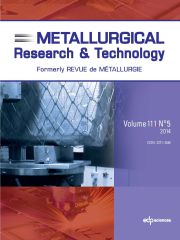Article contents
Prove of hydrogen formation through direct potentialmeasurements in the rolling slit during cold rolling
Published online by Cambridge University Press: 04 April 2014
Abstract
In this work, direct potential measurements during cold rolling of zinc and X20Cr13stainless steel were carried out in the rolling slit to follow the tribologic and galvanicmechanisms of hydrogen formation and absorption on the surface of the working rolls madeof DHQ1 grade steel. An Ag/AgCl in 3.5 M KCl reference microelectrode was used to recordthe open circuit potential of the electrochemical system roller-product immersed intocommercially relevant electrolyte (rolling emulsion) with a pH value of 4.5 and anelectric conductivity 46 mS cm-1. The potential shift into either negative or positivedirection of the rolls-product system gives information on the processes taking place atthe surface in the course of the friction. A detailed discussion of the in-situpotentiometry experiments reveals a stationary situation established between thedestruction and repassivation of the surface structures during continuous cold rollingaccompanied with intensive hydrogen evolution. Galvanic coupling of the working rolls withthe product significantly intensifies the hydrogen embrittlement related problems of therolls. Atomic hydrogen is adsorbed on the surface and exhibits a pressure supportedabsorption into the rolls during their whole lifetime.
Keywords
Information
- Type
- Research Article
- Information
- Copyright
- © EDP Sciences 2014
References
- 5
- Cited by

